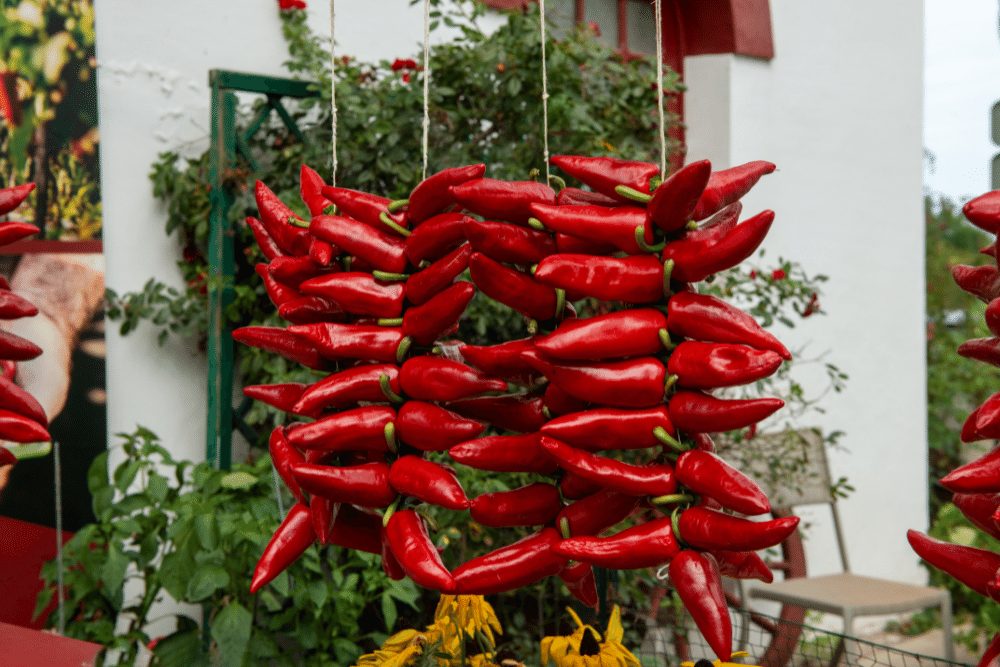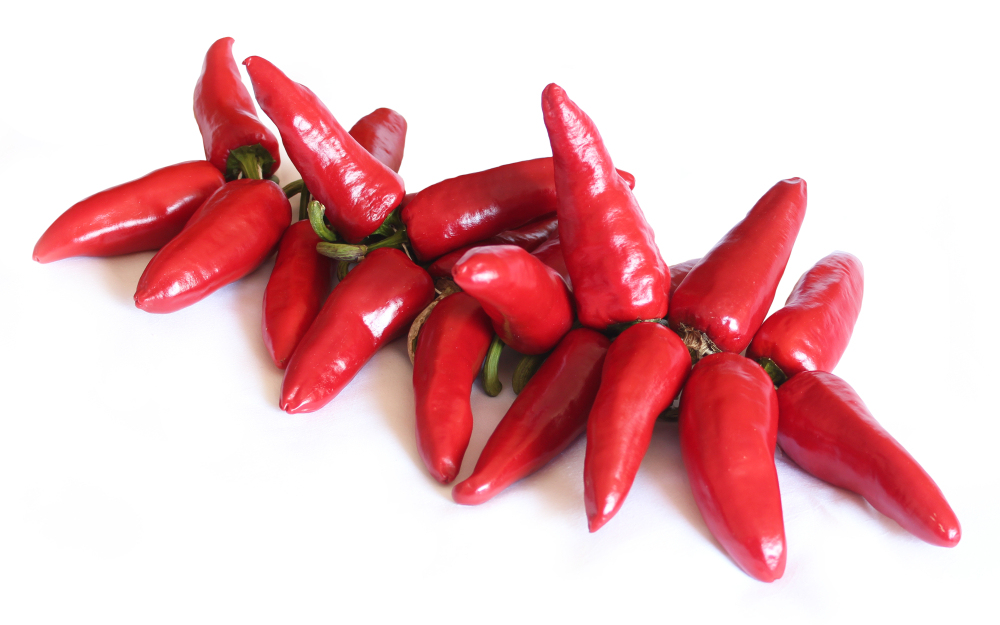Espelette pepper is one of the rarest Capsicum annuum peppers and the only spice in Europe with a protected designation of origin certification. This means that traditionally, there's a close connection between the land where it grows and the people that grow it—making it unique and highly sought after.
What Are Espelette Peppers?
Espelette peppers are a rare gourmet chili pepper named for the commune of Espelette in the Basque region of France, where the gorria variety of the peppers is cultivated.
Espelette chili peppers are also called Piment D’Espelette in French or Ezpelekato Biperra in Basque.
Basque navigator Gonzalo Percaztegi is believed to have brought Espelette peppers to the Basque region of France, along with maize, after a voyage with Christopher Columbus.
Espelette peppers descend from peppers that trace their origin to Central and South America, which came to Europe with Portuguese and Spanish explorers in the 15th and 16th centuries.
The Basque people adopted Espelette peppers in the 16th century after Gonzalo introduced them to the region. They thrived in the area’s slightly acidic soil, giving them a unique flavor.
The divine connection between the land, farmers, and the Espelette peppers saw the chiles recognized in 2002 as a protected designation of origin (PDO) commodity.
The PDO status protects the identity and integrity of Espelette peppers to ensure continued authenticity and quality.
Unless they are grown in the Espelette village or the other nine villages of the Basque region, the vibrant red peppers you have won’t be recognized officially as Espelette peppers. The same happens with Hatch peppers, which are named after the Hatch region of New Mexico, where they are grown.
Espelette chile peppers grow green and turn a brilliant red color when fully mature and ripened. They are rich in iron, fiber, potassium, and vitamins A, B6, C, and K.
In Basque, it’s common to see strings of Espelette peppers drying outside in the sun.

Is Espelette Pepper Spicy?
Espelette peppers register 500-4,000 SHUs on the Scoville Scale. They are considered mild peppers, bordering more on sweetness than hotness.
For comparison, jalapeno peppers have a range of 2,500-10,000 SHUs.
Dried Espelette peppers have a slightly smoky flavor that’s similar to the delicate flavor profile of smoked paprika. When fresh, their fruity flavor and mild heat are more noticeable.
Is Espelette Pepper Powder The Same As Paprika?
Paprika and Espelette pepper powder are not the same.
However, hot paprika has a similar flavor profile and heat level, making it a good substitute for Espelette pepper powder. A bit of smoked paprika can be mixed in to mimic the slightly smoky flavor of dried Espelette peppers.
Espelette pepper powder must use espelette peppers exclusively. Paprika is a blend of different dried red peppers such as cayenne peppers, aleppo peppers, poblano peppers, sweet red peppers, and others.
What Is Espelette Pepper Used For?
Although rare in most parts of the world outside France, Espelette pepper has earned its place as one of the most versatile chile peppers. It is a popular ingredient in French or Basque cuisine and other international cuisines.
Below are some common modern and traditional uses of Espelette peppers:
- Traditionally used by the people of Basque to preserve salted meats
- Glazing duck
- As a cooked condiment to make pepper paste, jams, and jellies
- Adding to champagne
- Dusting potato chips and French fries
- Adding to a cream sauce
- When fresh, they are chopped to garnish salads or diced in sauces, relish, and salsa
- Making pepper-flavored sea salt or pepper-infused oils
- Drizzling over cheesecake and chocolate cakes
- Sprinkling on hot chocolate
- Making piperade, a dish featuring onions, tomatoes, peppers, and Espelette peppers
- Making basquaise, a spicy sauce containing tomatoes, fresh peppers, and dried, powdered Espelette peppers.
- Spicing or seasoning stir-fries, soups, stews, roasted vegetables, pasta, and chilis

Where To Buy Espelette Pepper
In the Basque region and France, Espelette pepper is available fresh, raw, dried, ground, powdered, pickled, or pureed. Outside of France, you’ll rarely find Espelette chili peppers in other forms apart from powder.
You can buy Espelette pepper powder online from stores like Amazon. Espelette pepper seeds are also available in online stores.
If you want fresh Espelette peppers, you can visit the Basque region on the last weekend of October every year during the Espelette Pepper Festival.
So unique is the Espelette pepper to the people of Basque and France that they have a whole annual festival in Espelette, complete with parades, traditional Basque dances, concerts, games, and pepper sales!
What’s A Good Substitute For Espelette Pepper?
Since you may not be lucky enough to lay your hands on the coveted rare Espelette pepper in any form, you can replace it in recipes with substitutes like:
- Aleppo pepper
- Cayenne powder
- Crushed red pepper (red pepper flakes)
- Chipotle powder (spicier)
- Sweet paprika
- Smoked paprika
Can You Grow Espelette Peppers?
You can grow your own Espelette peppers with seeds bought online. However, the disadvantage of growing your own Piment D’Espelette is that it loses its authenticity.
The loss of authenticity is because the Espelette pepper won’t have grown in the Basque region it’s traditionally accustomed to.
Your self-grown Espelette peppers will also lose their quality. As mentioned earlier, the characteristic flavor of Ezpelekato Biperra owes a lot to the slightly acidic soils of the Basque country side. Much of that unique flavor will be lost if you grow them outside this location.
The people of Basque also follow strict guidelines for growing Espelette peppers, such as using pesticides restrictively and doing no irrigation. You may not manage to replicate these and other growing, harvesting, and post-harvest practices in your area.
But don’t lose hope! You can try your best to grow them as closely as the Basque people do. If you enjoy gardening and growing different pepper varieties, it could be a fun experiment.

